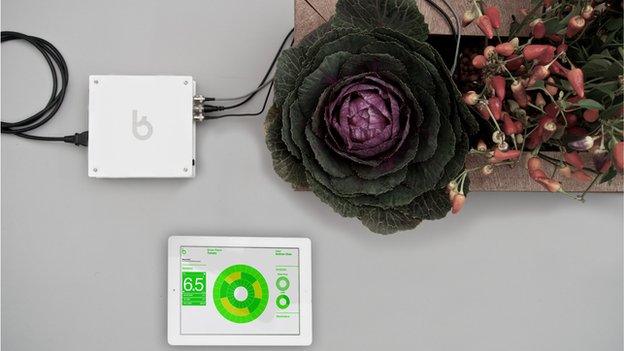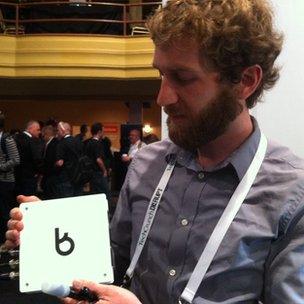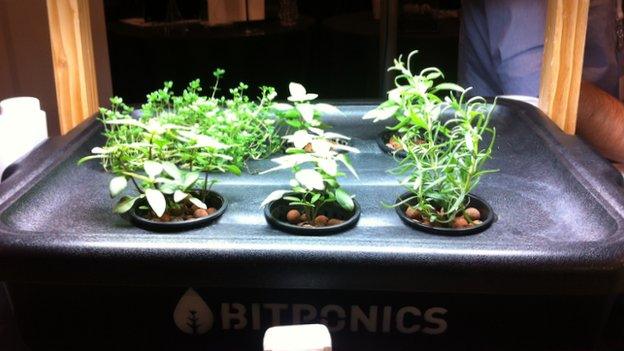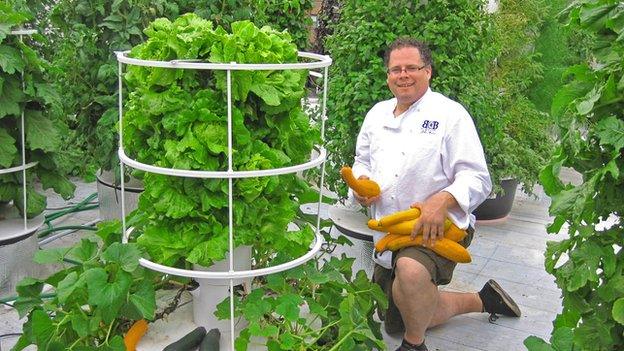The technology that's transforming gardening
- Published

How does your garden grow? Bitponics monitors how plants develop and stores the data in the cloud
With the holiday weekend coming up and the weather (hopefully?) taking a turn for the better, many of us may start feeling a bit green-fingered and turn our attentions to a spot of gardening.
But one New York-based tech start-up is hoping that worrying about seasons will be a thing of the past when it comes to growing your own plants, fruit and veg.
Bitponics claims to be "your personal gardening assistant". The system it sells is a cloud-based hydroponics gardening manager.
Many people may only have heard of hydroponics in terms of growing cannabis, but actually it is widely used in farming.
Hydroponics basically involves growing plants without soil, instead using a reservoir of nutrient solutions in water.
What Bitponics strives to do is automate hydroponic systems.
The technology it has developed is an electronic box that has sensors attached. These sensors, or probes, go into the reservoir of your hydroponic system and monitor things like pH levels, temperature, humidity, and the data is then sent wirelessly to the cloud.
Two outlets let you plug in lights or pumps, which can be set on timers to aid growing.

Michael Doherty showcased Bitponics at the Tech Crunch start-up event in New York
A web app gives you a grow plan, which notifies you by text or email when when you need to add nutrients or change the water reservoir.
Community sharing
"Right now our customer is, I guess, hobbyist or novice gardeners - people who have existing hydroponics systems," says Bitponics co-founder Michael Doherty.
"Hydroponics is really great for urban environments where you don't have a lot of space. You can do it indoors.
"But also it's great for anyone because usually the yield is a lot higher, you get more plants in a shorter period of time so you don't have to wait a full season."
In this digital world of sharing content and ideas, Bitponics also involves a community element, which Mr Doherty says is unique in its field.
"There's no automation device that has a community aspect that's web-enabled as we are," he says.
An online community of users can share growth plans, where you can share what works and what doesn't work with others for particular plants in particular systems.
"Eventually we'll have a library where you'll be able to find anything," he says.

The device currently has to be used with existing hydroponics systems, but Mr Doherty says they may soon be partnering with manufacturers who sell the actual systems
Hobby v business
On a commercial level, hydroponics is the most-used technology in greenhouse vegetable production in the US, says Dr Melissa Brechner, director at the CEA Center for Technology Transfer at Cornell University.
But for any individuals looking to make money from using hydroponics technology in their own greenhouse, Dr Brechner has this advice: "Try it first as a hobby rather than as an enterprise.
"I've seen a lot more interest in locally produced food and that has opened a market for some smaller growers.
"But you're probably not going to be able to make your entire living from one greenhouse worth of lettuce, although you might if you're willing to put the time in.
"We usually say the third person to own a greenhouse makes money with it."
From roof to table
Hydroponics and aeroponics - a type of hydroponics, but rather than growing in nutrient-rich water, grows in the air and the plants get sprayed with nutrients - technology is increasingly being utilised by businesses themselves.
John Mooney is the founder and chef at the Bell Book & Candle restaurant in Manhattan.
The restaurant, located in Greenwich Village, has little outdoor space so Chef Mooney decided to make use of the dead space it had - the roof - in order to grow his own vegetables.
He uses a system called, Tower Garden, a vertical, aeroponic growing system.

John Mooney says the technology allows him to utilise the roof, which would otherwise be dead space, and could not hold the weight of soil needed for a conventional garden
The concept of vertical farming is not new - the phrase was first coined by Gilbert Ellis Bailey in 1915 as pressure increased on already limited farmland - and involves growing produce either in a skyscraper greenhouse, or in this case, a tower.
Mr Mooney's rooftop is full of these white towers, where seeds are planted up along each tower's spine. Each tower has its own reservoir at the base, which is on a timer and has a pump that sprinkles the roots of the plants every 12 minutes.
He says it was important to be as close to the source as possible: "When you pick something with the roots attached, that's still living, that's probably the best benefit."
The roof garden grows everything from aubergines, tomatoes and chilli peppers to herbs and watermelons.
However, with a soilless system you obviously cannot grow anything that would be subterranean - so no onions or carrots, for instance.
And roof gardens are not immune to the weather either, regardless of the technology used. The garden was wiped out during Hurricane Sandy and needed reconstructing.
.jpg)
The Tower Garden is now available for home use and can be set up indoors
While growing his own vegetables obviously makes economic sense, Chef Mooney says the benefits are much broader than that.
"There's two ways to look at it. It does pay for itself. I know how much I would spend on vegetables if I'm purchasing everything in, which is about $6,000 a month, a little more probably.
"But the quality that we produce, having it on location - growing for consumption not for transport - and then having the staff involved in the process brings much more to the table than the actual monetary value."
Design challenges
Aeroponics technology does have its difficulties though.
"What happens if the nozzles clog or the pumps fail?" says Dr Brechner.
"With aeroponics there is absolutely no water holding capacity; if your pump fails your plants can all be dead in 10 minutes. If it's a hot sunny day your plants are just going to wilt and die.
"It's not the best system."
Tim Blank, who developed the Tower Garden technology, acknowledges that, historically, aeroponics has had its challenges but believes he has overcome them with his design.
"The design in aeroponics systems is using misters. Hydroponic nutrient solution is full of things like calcium and magnesium - which cloud up the mister in a short amount of time," he says.
So what was the solution?
To put it simply, bigger holes in the shower head and using a lower pressure pump to prevent clogging.
"This has an energy benefit as well, as previously high pressure pumps used a lot of electricity," he says.
Control of your food
Mr Blank, who was previously chief horticulturist and greenhouse manager of the Living with the Land pavilion at Disney's Epcot theme park in Florida, founded Future Growing to sell the Tower Garden technology on a commercial level.
It is now available to individual consumers too, after nutritional products group Juice Plus+ bought the rights to produce and distribute Tower Gardens for home use in 2011.
Although one tower and the kit that comes with it will set you back $499 (£330), Mr Blank believes it will pay for itself in "less than a few years".
And he believes the market for home-growing technologies will, pardon the pun, only grow.
"People are concerned about food safety. They want to be in control of their own food. We've created technology that allows them to grow in their backyard."
He adds: "The primary challenges in agriculture are the carbon footprint and water usage. With vertical aeroponics, we are using up to 95% less water and up to 90% less land than traditional agriculture.
"In a world we live in where farmers feel like their future's threatened, the great news is the technology is there to help them."